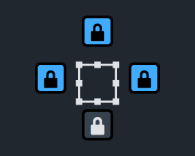Frame constraints
In Dorico Pro, constraints define the relationship between each of the four sides of a frame and the corresponding page margins.
Frame constraints lock each side of frames to the corresponding page margin, meaning you can change the page size, orientation, and/or page margins while keeping the frame in proportion. For example, a music frame that fills the entire height and width of a page has constraints on all four sides. All sides have an inset of zero, which means that the edges of the frames are in line with the page margins. If you change the page size and/or orientation, the frame size changes accordingly so that it always fills the page.
If you remove a constraint from one side of a frame, that unlocks that side of the frame from the page margin, meaning you can determine a fixed width/height that prevents that side of the frame from adjusting, even if the page size, orientation, and/or page margins change.
Example
You have a header text frame that you want to fill the full width of pages, remain at the top of pages, but maintain a fixed frame height even if the page size, orientation, and/or page margins change. To achieve this, you can lock the top, right, and left constraints but unlock the bottom constraint to give the frame a fixed height. The unlocked bottom constraint means, for example, that the frame does not get taller if the page size increases, or shorter if the page size decreases.

In the Frames panel, you can define the constraints for all types of frames that are available in Dorico Pro. All new frames have four locked constraints by default. You can unlock the top or bottom constraint to give frames a fixed height, and unlock the right or left constraint to give frames a fixed width.
Frames must have at least one locked constraint from each pair of top/bottom and right/left, such as top and right.